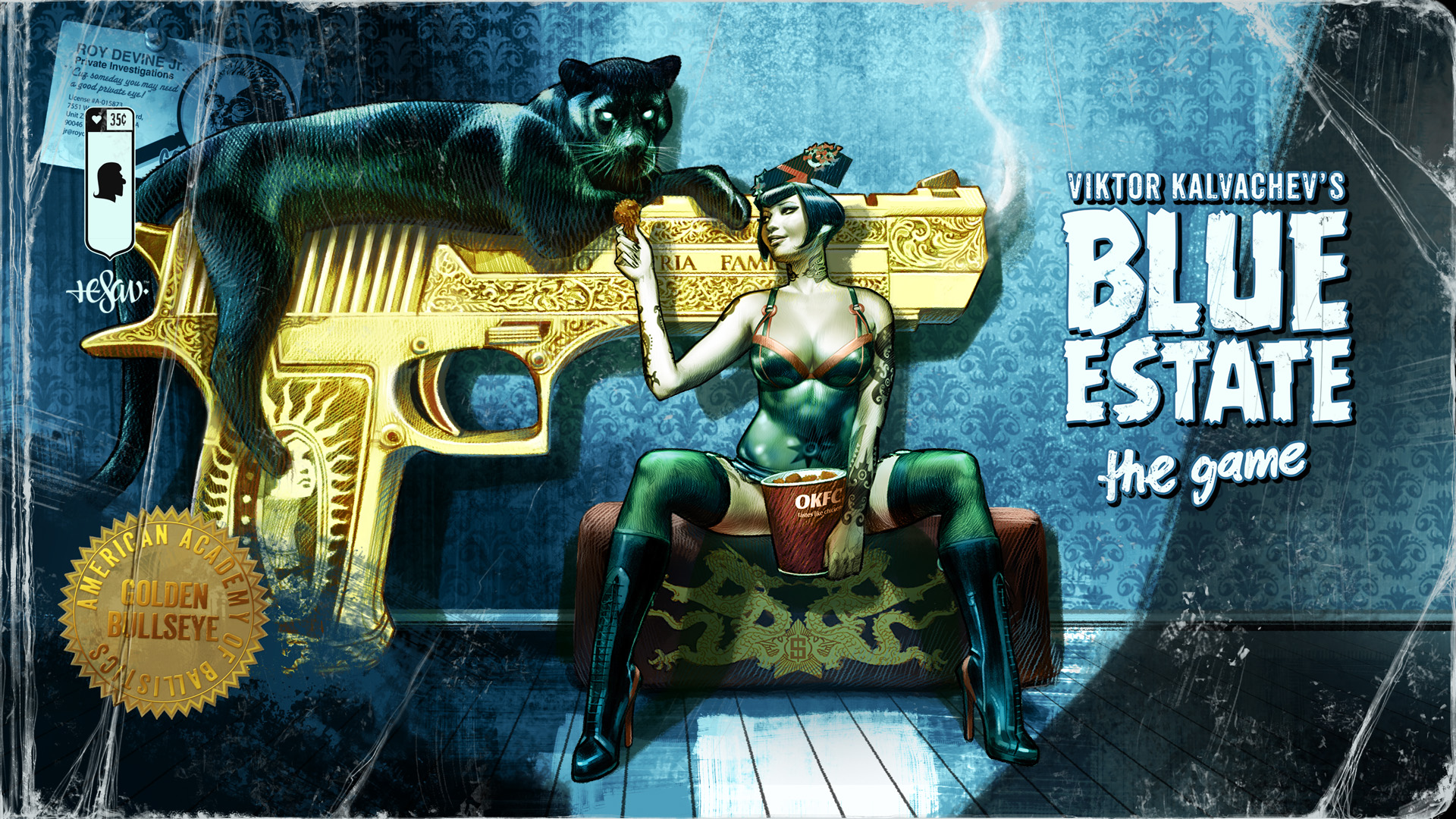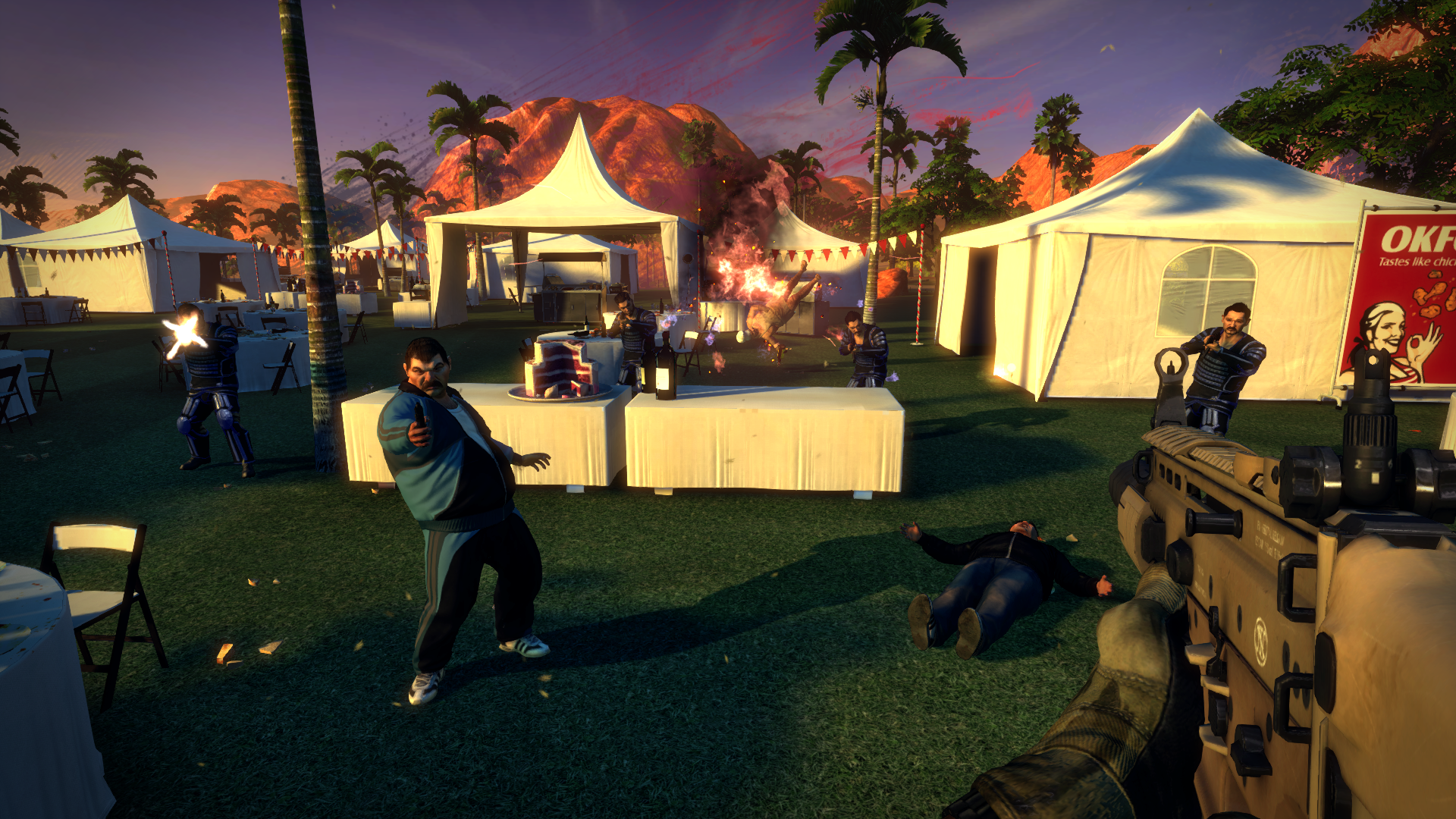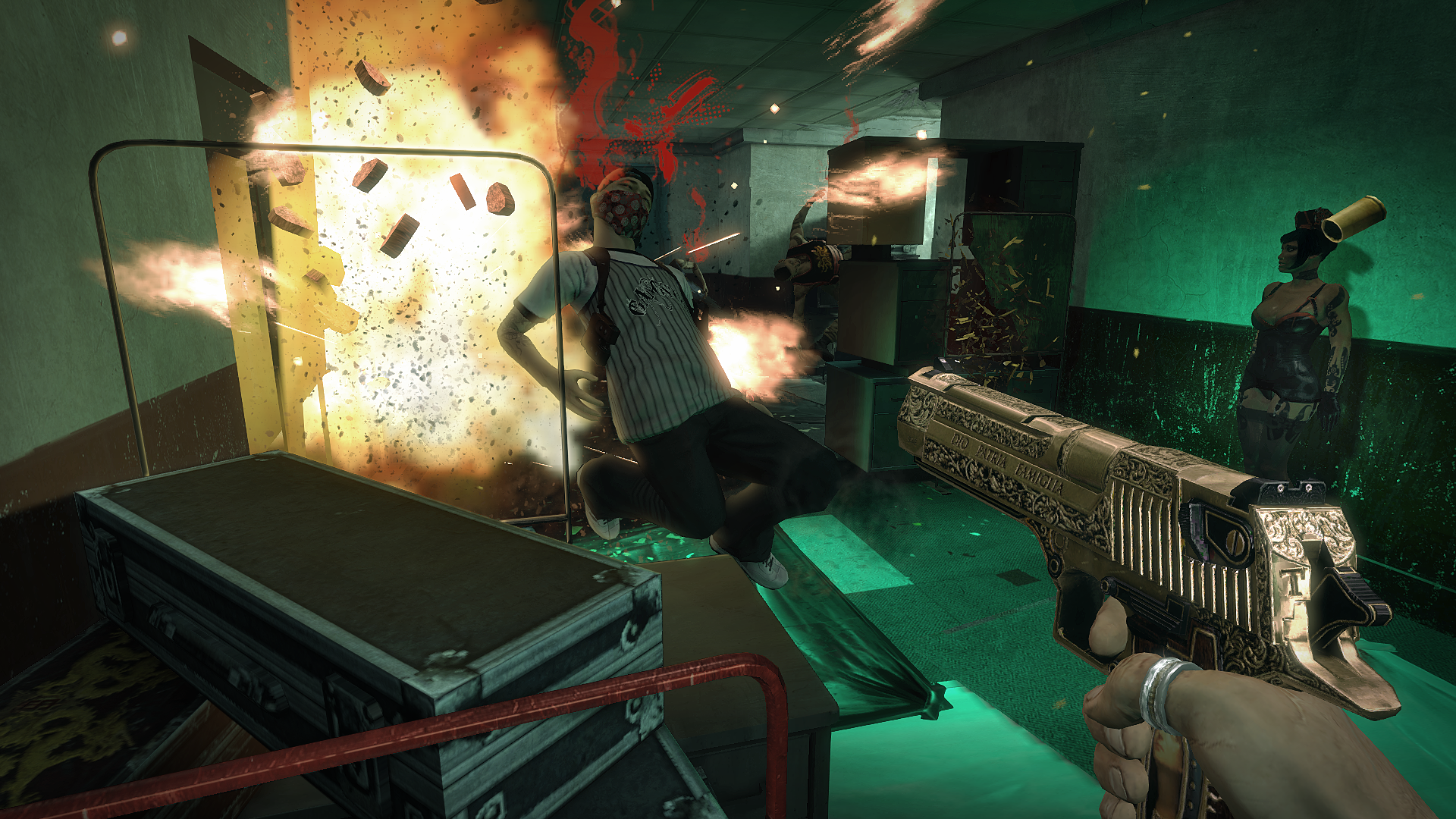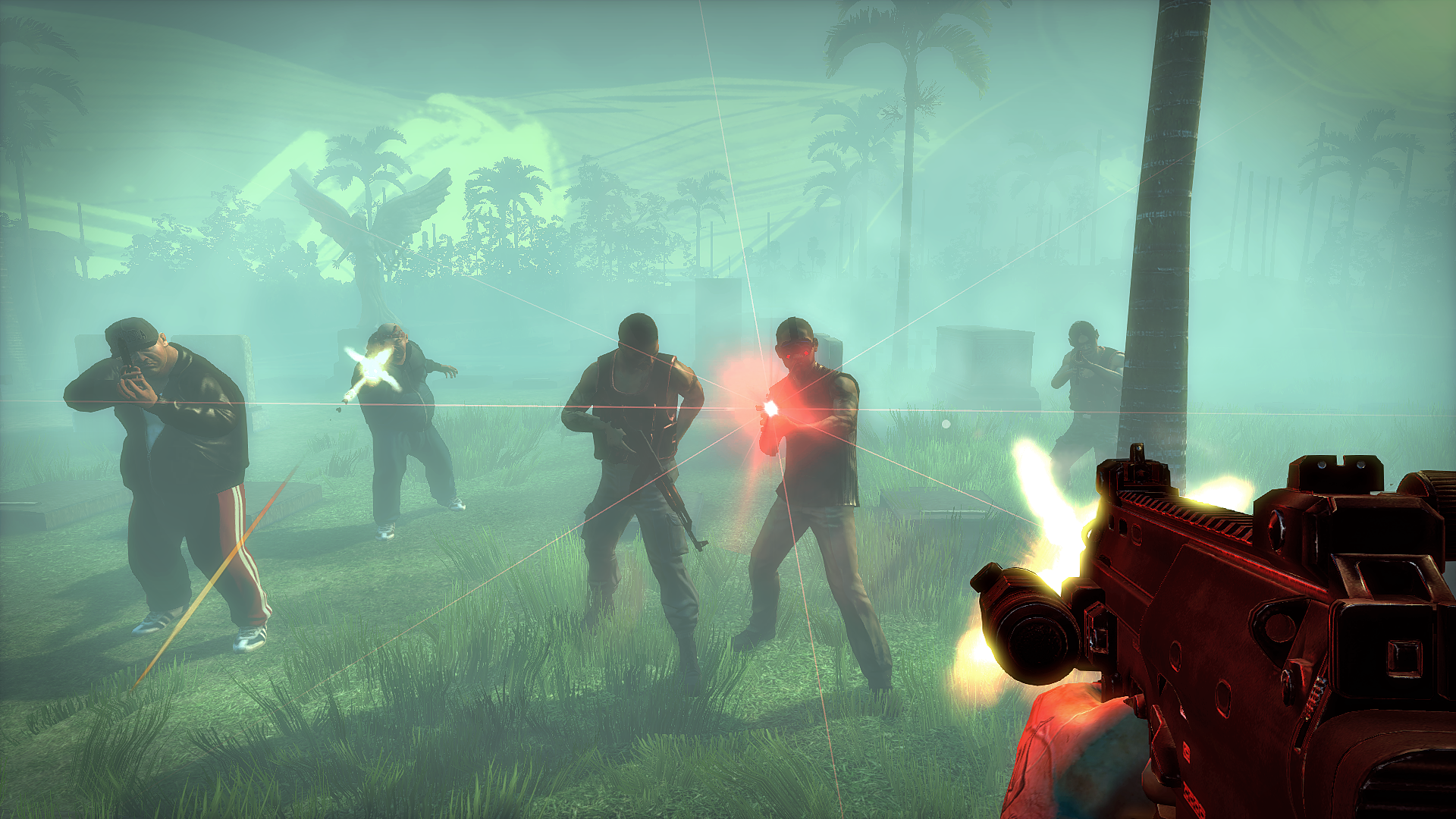Blue Estate is an on-rails shooter that originally released on the PlayStation 4 in June of 2014. It has now made its way onto the Xbox One, complete with Kinect and controller support.
Based upon Viktor Kalvachev’s graphic novel series of the same name, Blue Estate has you play as Tony Luciano, the politically incorrect son of Don Luciano, head of the West Coast Cosa Nostra. Upon starting the game you are greeted with the following text:
Disclaimer: The people you are about to encounter should not be confused with heroes. They are mostly terrible people who say and do horrendous things. Especially TONY LUCIANO. No one in this game is based on anyone in the real world and they should probably all be arrested.
It’s an interesting disclaimer that perhaps acts more as an excuse for crude jokes than as a mature content warning. No doubt inspired by the films of Quentin Tarantino and Guy Ritchie, Blue Estate tries to present itself as a hardboiled crime comedy series set in the seedy underbelly of Los Angeles. And while I’m not familiar with the comic and therefore can’t assess how well it works in that medium, Blue Estate the game is full of jokes and story beats that miss the mark more often than not.
After his favorite girl, Cherry, is kidnapped and forced to work at a rival gang’s strip club, Tony’s challenge is to go and rescue her. Our protagonist, however, is not a man of subtlety or intellect, so of course things go wrong from the moment he enters the Twin Dragon club. Tony draws the attention of the club’s proprietors, the brothers Sik, sparking an all-out war between the Italian and Korean mobs. What follows is his attempt to right his many wrongs by murdering the scores of henchmen sent to kill him.
Unfortunately, the story is largely juvenile and lacking in any real wit or humor. Tony will also frequently say terrible things about his enemies that are borderline racist – the offensiveness of these lines is immediately felt, to say the least. Now, I do not claim to be a guardian of the public good – that is not my station or intent here in this review – so I will say only that comments such as those found in IGN’s original PS4 review are, in my opinion, highly suggestive of a reviewer who shut himself off intellectually and refused to acknowledge any of Blue Estate’s good qualities.
There aren’t many things a game can be that I’d consider worse than “boring,” but “artlessly offensive” is one of them. From the title screen on, Blue Estate’s treatment of gender and race are a constant distraction. – Vince Ingenito, IGN
The fact of the matter is that while Blue Estate’s failures in the story department are both numerous and readily apparent, it isn’t all bad. Tony, a man who swaggers about and prides himself with his looks, can be likeable in a very coarse way. A recurring joke about his character is that his long hair will frequently obscure his vision, requiring you the player to swipe it out of frame. How Jackie Estacado in Starbreeze’s The Darkness didn’t suffer from this same problem I’ll never know. Maybe he tied his hair back in a ponytail during gunfights.
And Tony isn’t the only character at play here either – players will also assume the role of Clarence, an ex-Navy Seal hired by Tony’s father to clean up his son’s mess. Clarence, thankfully, isn’t as rude as Tony or any of the other supporting cast members. He’s a bit of a saint by comparison, agreeing to become the Don’s personal killer in order to save his grandmother’s home.
Ultimately, your enjoyment of Blue Estate’s story will largely depend on how seriously you want to think about its characters, situations, and dialogue. Even as a piece of shock entertainment it’s relatively tame compared to the films it tries to emulate. It’s all over in a fairly short amount of time anyway, clocking in at around 3 hours. Its humor is hit or miss but the game never tries to be anything but a sleazy, dark adventure.
Blue Estate’s visuals are a tough nut to crack. On the one hand, it’s an okay looking game that delivers some sharp visuals; it’s no graphical powerhouse, so you won’t be confusing it with titles like Ryse or The Order: 1886, but it performs well and doesn’t offend with its admittedly rather bland environments. By and large, it looks like a last generation game running at a 1080p resolution, and that isn’t a bad thing.
No, Blue Estate’s biggest problem is its failure to capitalize on any coherent visual style. That it should be based on an Eisner Award-nominated graphic novel is enough to make me question why it doesn’t bother to replicate the look of its source material—cutscenes are presented in a delightful comic book fashion that shows off the great artistry of creator Viktor Kalvachev; level intros receive their own mock issue covers; and there are plenty of small details that go to great lengths to match up with their comic book counterparts. And yet despite all that, the moment to moment gameplay is unoriginally presented by way of 3D models that could be found in any number of low rent shooters. It’s a rather huge visual gulf to cross, and it isn’t one that can be ignored for very long.
This is because Blue Estate sort of acknowledges this discrepancy by adding in visual flourishes that are very clearly inspired by comic book aesthetics. Light streaming in through a window will be visualized by the classic and unmistakable Ben-Day dot pattern, and even blood spurts, something you’ll be seeing a lot of in Blue Estate, are comprised of this same pattern. This halfway measure is a strange inclusion that doesn’t add much to the game’s presentation.
If the game had only attempted a bolder graphical style not unlike Borderlands or Telltale’s The Wolf Among Us, where characters are heavily outlined and richly colored, then might it have been an easier sell, graphically-speaking. It probably would not have approached the same level of fidelity seen in the comics themselves, but it would have nevertheless helped in adapting the material more faithfully. As it stands, Blue Estate is a decent looking game that could have been a great looking game.
Designed from the ground up as a motion-controlled rail shooter, Blue Estate is one of those rare games that support Microsoft’s Kinect. Your on-screen aiming reticule is controlled with your dominant hand, and shooting is automatic, with some generous aim assist to help you line up those ever important headshots. Gestures, or motion based quick-time-events, are controlled with your opposite hand: these will range from the aforementioned hair swiping to the dodging of certain melee attacks, usually during end of level boss battles. And whilst shooting is automatic, reloading is not; to reload, gamers must simply lower their aiming hand anywhere off-screen (I found the best way to go about this was to pretend as though I was reaching for a gun at my hip). When the situation permits it, raising your dominant arm up over your head and behind your back will switch between your primary weapon (a handgun with infinite ammo), and a level specific secondary weapon (shotgun, Uzi, AK-47, etc.). Kinect works very well here indeed, which is a nice treat.
Fortunately for those gamers who prefer more “traditional” controls, developer HESAW has also implemented gamepad support into Blue Estate. I have a sneaking suspicion that the reason for the game’s delay relative to its PS4 release was due in part by Microsoft’s decision to unbundle Kinect from every Xbox One—I reached out to the developer for answers but received no response. Gamepad controls work as you’d expect; just substitute “dominant hand” with right analogue stick, “reload” with X, and “switch weapon” with Y. A nice little feature about having these two different control methods is that co-op play allows for one player to be on the sticks and the other to use Kinect.
Elsewhere, the game features two standard modes of play: Story and Arcade. Story, as you would expect, follows Tony and Clarence through their gore-filled adventures, while Arcade mode (exclusive to this version of the game) has you playing through remixed versions of levels seen in Story mode. Here you will have to kill enemies at regular intervals to stay alive; you are given five seconds to dispatch an enemy before its game over. More interestingly, however, is that as you kill enemies you unlock higher tiers of increasingly powerful weapons, not unlike Call of Duty’s “Gun Game” mode. Arcade mode is much more frenetic than Story mode and can be something of a time waster if online leaderboards are your thing. I had quite a bit of fun with both modes, which have three difficulty settings each – Normal, Abnormal, and Crazytrain – that serve to up the challenge, although not dramatically so.
Otherwise that’s about what you can expect out of Blue Estate. The story, as mentioned earlier, will probably take you around 3 or so hours to complete, with levels lasting anywhere from 20-30 minutes (reflecting their more chaotic pace, Arcade levels can be significantly shorter in length). Affordably priced, Blue Estate is a game that can be completed in a single sitting or two, but there is definite enjoyment to be had here.









